A, B, C, D-PILLARS
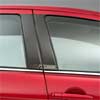 Vehicles have two A-pillars, one on either side of the front windshield. The A-pillar usually supports the roof of a vehicle and is located in front of the driver. On convertible models it also represents the main roll-over protection, and is among the strongest body parts.
Vehicles have two A-pillars, one on either side of the front windshield. The A-pillar usually supports the roof of a vehicle and is located in front of the driver. On convertible models it also represents the main roll-over protection, and is among the strongest body parts.B-pillars are the posts between the first door and the second door. C-pillars are the posts after the second door of the car. D-pillars are the vertical or diagonal posts located at the extreme rear of the car. Generally found in station wagons and even a few sedans. The pillars in a car are an integral part of the car body that provide support and strength.
ABS (ANTILOCK BRAKING SYSTEM)
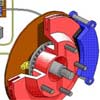 Originally developed for aircraft braking systems in the first half of the twentieth century, the Antilock Braking System (ABS) is essentially used to improve stability during braking and in some cases it can even shorten braking distances altogether. Appearing in various mechanical forms before, the first modern electronic four-wheel ABS system was co-developed by Mercedes-Benz and Bosch.
Originally developed for aircraft braking systems in the first half of the twentieth century, the Antilock Braking System (ABS) is essentially used to improve stability during braking and in some cases it can even shorten braking distances altogether. Appearing in various mechanical forms before, the first modern electronic four-wheel ABS system was co-developed by Mercedes-Benz and Bosch.In cars without ABS, during hard braking the wheels lock, thus making impossible for the car to be steered and the vehicle most likely skids into the obstacle the driver is trying to avoid. The ABS prevents wheel lock-up during braking maneuvers by using sensors which can determine if any wheel is slowing down more than the others and computer-controlled valves which can limit the pressure delivered to each brake cylinder on demand. The whole system is controlled via a master ECU (Electronic Control Unit).
Since the ABS constantly pumps the brakes during a braking maneuver the driver can concentrate on steering the car while applying constant pressure on the brake pedal, without fear of losing control of the car's direction. Also, while braking on uneven surfaces (left tires on gravel and right ones on tarmac, for example) the ABS can keep the car's stability under control.
ACC (ADAPTIVE CRUISE CONTROL)
With the help of a laser or a radar sensor, the Adaptive Cruise Control (ACC) system recognizes preceding vehicles, calculates their speed and keeps the distance required by automatically acting on the brakes and/or engine power.
ACC can scan the area in front of the vehicle in order to determine the distance to the vehicle ahead. The information gathered by the sensors and/or radar is used to warn the driver if he/she is tailgating or to maintain an automatic safety distance to the vehicle by cutting engine power or activating brakes if necessary.
Some ACC systems can actually get the vehicle to a complete halt without any driver intervention in case they're detecting an impending impact with the object in front of the car.
ACC (AUTOMATIC CLIMATE CONTROL)
The Automatic Climate Control is an air-conditioning unit which can automatically set the temperature desired by the driver without being influenced by the outside temperature or other factors. The most advanced climate control systems nowadays use different sensors and can take into account outside temperature, the sun rays' intensity and even the angle on which they're setting on the car in order to automatically regulate the temperature requested by the driver.
AUTOMATIC TRANSMISSION
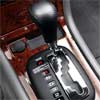 A transmission is a part of the drive train. The transmission is used to transfer the engine power to the drive wheels. It also allows the driver to choose more power (1-st gear) or more speed (4-th or 5-th gear) by changing the gear ratio.
A transmission is a part of the drive train. The transmission is used to transfer the engine power to the drive wheels. It also allows the driver to choose more power (1-st gear) or more speed (4-th or 5-th gear) by changing the gear ratio.In an automatic transmission, gears are changed automatically, according to the engine RPM, vehicle speed, load and other factors. A typical automatic transmission has four or five forward gears or speeds. The highest gear is sometimes called an Overdrive or O/D. Some automatic transmissions also have a manual shift mode allowing the driver to select gears manually.
To change the gear ratio, most automatic transmissions use planetary gears. A typical planetary gear consists of three main parts: outer Ring Gear, inner gear, called Sun Gear, and Planetary Carrier with three or four small gears that are placed between the Inner Sun Gear and the Outer Ring Gear.
ACT (ACTIVE SUSPENSION TECHNOLOGY)
The Active Suspension Technology is a definition for any suspension system which can modify its settings in real time to control body motion in response to any road abnormality or during cornering, braking or acceleration. These type of systems usually respond to inputs from either the road or the driver using different sensors. At least in theory, a vehicle equipped with an active suspension can provide both a comfortable and firm ride, thus keeping a perfect balance between smoothness and good road handling.
AIR BAG
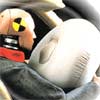 Airbags are built into the steering wheel for drivers and in the front dash for passengers. The airbags inflate when the car is struck from the front. Airbags are only useful when used in conjunction with a seat belt since they require that the occupant be in a specific position to be effective. Newer generation airbags are sometimes designated 'depowered' and are less obtrusive in their actuation.
Airbags are built into the steering wheel for drivers and in the front dash for passengers. The airbags inflate when the car is struck from the front. Airbags are only useful when used in conjunction with a seat belt since they require that the occupant be in a specific position to be effective. Newer generation airbags are sometimes designated 'depowered' and are less obtrusive in their actuation.AIR DAM
An air dam is a huge air inlet in the car's front bumper. It allows air to enter the radiator to cool the fuming engine. Air dams help cool the car engine and also control the aerodynamic qualities of the car.
AIR SUSPENSION
A type of vehicle suspension system that uses air springs instead of conventional steel springs. This system helps to maintain tyre position at an optimum angle that upholds traction control, steering control, braking, and even the acceleration. Powered by an engine driven or electric air pump or compressor Air suspension helps in providing a smooth ride quality and in some cases self-leveling. Air Suspension increases the friction between tyres and the road and offers greater control and stability to the driver.
ANTI-ROLL BARS
 An anti-roll bar helps the car to maintain balance and prevents the car from rolling during tight cornering. It does not affect the suspension stiffness when both wheels are deflected equally in the same direction. It is also called a stabilizer bar, an anti-sway bar, a roll bar, or an anti-roll bar (ARB). Its purpose is to try to keep the car's body from 'rolling' during a sharp turn. It connects opposite (left/right) wheels together with short lever arms that are linked by a torsion spring. Anti-roll bars keep the car from rolling over when taking sharp turns.
An anti-roll bar helps the car to maintain balance and prevents the car from rolling during tight cornering. It does not affect the suspension stiffness when both wheels are deflected equally in the same direction. It is also called a stabilizer bar, an anti-sway bar, a roll bar, or an anti-roll bar (ARB). Its purpose is to try to keep the car's body from 'rolling' during a sharp turn. It connects opposite (left/right) wheels together with short lever arms that are linked by a torsion spring. Anti-roll bars keep the car from rolling over when taking sharp turns.BASIC WARRANTY
Also called the comprehensive warranty since it offers the widest coverage, this is the shortest duration guarantee. Generally covers everything but wear (tires, brake pads) items and maintenance (oil, spark plugs, filters) under normal use and maintenance. Usual range is 3 years/60/000
kilometers to 5 years/100,000 kilometers.
BHP
Brake horsepower or BHP is a commonly used unit for measuring power of a car engine. This unit of measurement traces back to the days of the industrial revolution, when a steam engine was rated by how many horses it replaced. It is slightly different from the unit Horsepower (HP). The higher the BHP figure, the more powerful is the engine. It indicates the power of a car engine.
CHILD RESTRAINT SEAT
Child seats can be integrated into the rear seats of vehicles. When not in use, the child seat folds into the regular perch for adult use.
CURB WEIGHT
The overall weight of the vehicle.
CHILD SAFETY LOCKS
Rear door locks that can disabled so that rear seat passengers (notably children) cannot open the door.
COMMON RAIL DIRECT INJECTION (CRDI)
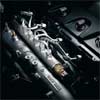 This is one of the most advanced diesel technologies in the world. A perfect blend of performance and fuel economy, CRDi engines are based on direct injection technology and have rails (tubes) which inject pressurised fuel directly into the engine. The common rail connects all the injectors and contains fuel at a constant high pressure. A small amount of fuel is supplied to the engine before and after the actual charge.
This is one of the most advanced diesel technologies in the world. A perfect blend of performance and fuel economy, CRDi engines are based on direct injection technology and have rails (tubes) which inject pressurised fuel directly into the engine. The common rail connects all the injectors and contains fuel at a constant high pressure. A small amount of fuel is supplied to the engine before and after the actual charge.The high pressure in the common rail ensures that, when injected, the fuel atomises to a very high degree and mixes consistently with the air, thereby leaving minimal unused fuel. Fuel quantity, engine pressure and timing of fuel injection are controlled electronically. The injectors have variable control heads which ensure that a highly precise amount of diesel goes into each cylinder. The onboard computer makes sure that the fuel is injected at the just the precise moment. This significantly improves engine efficiency and reduces noise and vibrations as well.
COLLAPSIBLE STEERING
 In the event of a head-on accident, the driver bumps against the steering wheel. A collapsible steering has a telescopic shock absorber to reduce the impact on the driver's head or chest. A collapsible steering provides better safety to the driver than normal steering columns during accidents or hard braking.
In the event of a head-on accident, the driver bumps against the steering wheel. A collapsible steering has a telescopic shock absorber to reduce the impact on the driver's head or chest. A collapsible steering provides better safety to the driver than normal steering columns during accidents or hard braking.CRUISE CONTROL
Cruise control (sometimes known as speed control or auto-cruise) is an application that automatically controls the speed of an automobile. The driver sets the speed and the system takes charge of the throttle of the car to maintain a constant speed. It is a control mechanism for keeping an automobile at a set speed. Cruise control allows you to relax and enjoy the drive without having to worry about maintaining speed or minding.
DAMPERS
Dampers are also known as shock absorbers. They maintained the speed of a car when suspension's springs responds to holes and bumps in the road surface.They stabilize the speed of the car whenever it reacts to unwanted motions due to bounce, bend, brake dive, and acceleration squat.
ENGINE
The internal combustion engine comes in many different forms, from 4 cylinders to 12. More cylinders usually means a smoother, more powerful engine, but worse fuel economy. An engine's size is measured in liters and bigger engines usually have more power, but worse fuel economy.
All new cars have fuel injected engines. DOHC means double overhead camshaft and this generally describes the most sophisticated engines available. SOHC means single overhead camshaft and they are considered just a slight step below the DOHC variety. OHV means overhead valve and these are older designs, usually mostly by domestic brands. Though older some have been thoroughly refined for excellent performance.
SUSPENSION
Almost all cars have independent front suspension (with the exception of a few older sport utility vehicles). Most systems use MacPherson struts (shock and spring one unit) while a few use the more expensive and complex double-wishbone system. Although the latter is supposed to be better, BMW uses MacPherson struts with excellent results, so either system works well.
HEAD ROOM, LEG ROOM, SHOULDER ROOM
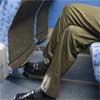 All interior dimensions are given from fixed standard points inside the cabin to dummies representing the 'average' human. The individual dimensions aren't important, but should be used instead as a comparison between competitive vehicles. For tall drivers and passengers, head- and legroom are the most important criteria. If you plan on carrying lots of passengers, rear shoulder room may be more critical.
All interior dimensions are given from fixed standard points inside the cabin to dummies representing the 'average' human. The individual dimensions aren't important, but should be used instead as a comparison between competitive vehicles. For tall drivers and passengers, head- and legroom are the most important criteria. If you plan on carrying lots of passengers, rear shoulder room may be more critical.GROUND CLEARANCE
The distance between the bottom of the car and road surface. This is a key measurement for trucks and sport utility vehicles being used off-road (more is better in that case).
HYBRID CAR
In general, the term 'Hybrid Car' means that a car is powered by two or more different types of energy. Currently, the most common type of a hybrid vehicle is the Hybrid Electric Vehicle (HEV). A Hybrid Electric Vehicle combines a conventional internal combustion (gasoline or diesel) engine with an electric motor, which is powered by an additional specially designed battery pack.
The common challenge the car manufacturers face is how to improve the fuel economy and lower harmful emissions without sacrificing power and comfort. During a regular daily driving we rarely use full engine power. To make enough power available when we need to pass or merge, the car manufacturers have to pack their vehicles with bigger engines. A bigger engine means poor fuel economy and hig
her emissions.
MCPHERSON STRUTS
The McPherson strut is a type of car suspension system widely used in modern vehicles. It is a special kind of shock absorber that is used on the front suspension, which replaces the upper control arm and ball joint. Some struts have coil springs around them while others do not. It can be used for both front and rear suspensions, but it is mostly found in the front where it provides a steering pivot as well as a suspension mount for the wheel.
NAVIGATION SYSTEM
This is an audio-visual electronic system with a screen that is placed at a driver-preferred location within the vehicle. This system is city-based and programmed accordingly. It provides directions to a destination using arrows, a map, or both. The driver needs to insert destination details and this system uses its database to plan out a known route and relays the information accordingly to the driver.
PARK-ASSIST SYSTEM
The park-assist system warns the driver of any object that comes close to the rear bumpers of the car. Each car manufacturer has different distance settings. When an object gets closer than the specified distance the device alerts the driver. Makes parking the car easy and helps the driver avoid obstacles in the way.
KEYLESS ENTRY
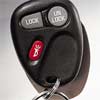 An electronic key fob that locks and unlocks the car's doors remotely. Often works in conjunction with a the alarm and/or immobiliser. It is considered a safety feature because it allows drivers to unlock the door before they reach their vehicle, avoiding the vulnerable position of fumbling with keys in suspect locations.
An electronic key fob that locks and unlocks the car's doors remotely. Often works in conjunction with a the alarm and/or immobiliser. It is considered a safety feature because it allows drivers to unlock the door before they reach their vehicle, avoiding the vulnerable position of fumbling with keys in suspect locations.SPOILER
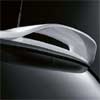 An aerodynamic (shape of objects that affects the flow of air, liquid, or gas) device that changes the direction of the airflow in order to reduce lift or aerodynamic drag, and/or improve engine cooling. Spoiler is an air deflector mounted usually at the rear of an automobile to reduce lift at high speeds.
An aerodynamic (shape of objects that affects the flow of air, liquid, or gas) device that changes the direction of the airflow in order to reduce lift or aerodynamic drag, and/or improve engine cooling. Spoiler is an air deflector mounted usually at the rear of an automobile to reduce lift at high speeds.TRANSMISSION
Transmissions are divided into the manual and automatic variety. Manuals come in five-and six-speed variations. Six-speeds are only necessary on pure sports cars. Automatics can be three-speeds (common on econo-cars), 4-speeds (the most plentiful variety) and 5-speeds (used mostly on luxury cars and a few sport utility vehicles.
TACHOMETER
A tachometer measures how fast the car's engine is spinning. The red zone is the engine's operating limit. If the car is a small four-cylinder, best performance will be achieved with higher rpm (revolutions per minute), while a larger motor (i.e. a V-8) will seldom need to go faster than 4,000 rpm.
TORQUE
Torque is measured in lb.-ft. and is an excellent measurement of how fast a vehicle can accelerate or how heavy a trailer it can pull. Like horsepower, the rpm (revolutions per minute) at which max torque is developed is important. Engines (such as large displacement V-8s and diesels) that reach max torque at speeds below 3,000 rpm are generally best for towing and hauling.
TRACTION CONTROL
Traction control systems use the anti-lock brake (ABS) computer equipment to prevent wheelspin caused by over-enthusiastic application of the throttle. Traction control then notes when the wheel is spinning (i.e. on wet or icy roads) and then cuts the power from the engine or applies the appropriate brake to regain traction. The system is most useful on large, powerful rear wheel drive cars that tend to skid excessively on snowy roads.
WHEELBASE
The length between the front and rear axles. Generally, larger vehicles have a longer wheelbase. However, there are exceptions because of the new 'cab-forward' designs which push the wheels closer to the bumpers. A longer wheelbase is beneficial to ride, interior and cargo space as well as handling. However, a longer wheelbase may give the vehicle a larger turning diameter which makes parking lot maneuvering more difficult.
WATER POUMP, COOLING SYSTEM
A water pump is an important part of the engine cooling system. It provides circulation of the engine coolant (antifreeze) through the cooling system . A water pump pushes the coolant through the passages (water jackets) in the engine cylinder block and cylinder head and then out into the radiator. This helps to keep the engine from overheating; the hot coolant passes through the radiator where it cools down and then returns back to the engine.
A water pump is usually driven by the engine through the drive belt. Sometimes it's driven by a timing belt. A water pump consists of the housing with the shaft rotating on the bearing pressed inside. At the outer side there is a pulley mounted on the shaft. At the inner side there is a seal to keep the coolant from leaking out and the impeller that acts like a centrifugal pump (see the lower picture).













0 അഭിപ്രായ(ങ്ങള്) :
Post a Comment